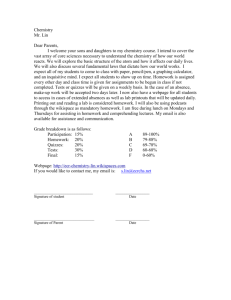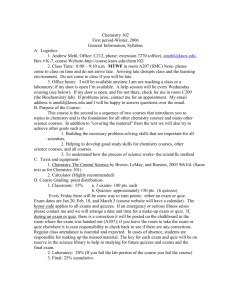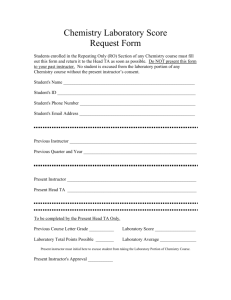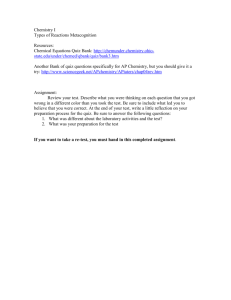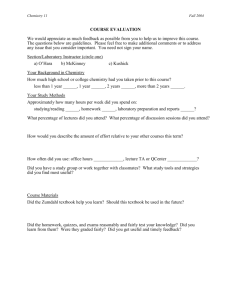doc - (COSMOS) at BGSU
advertisement
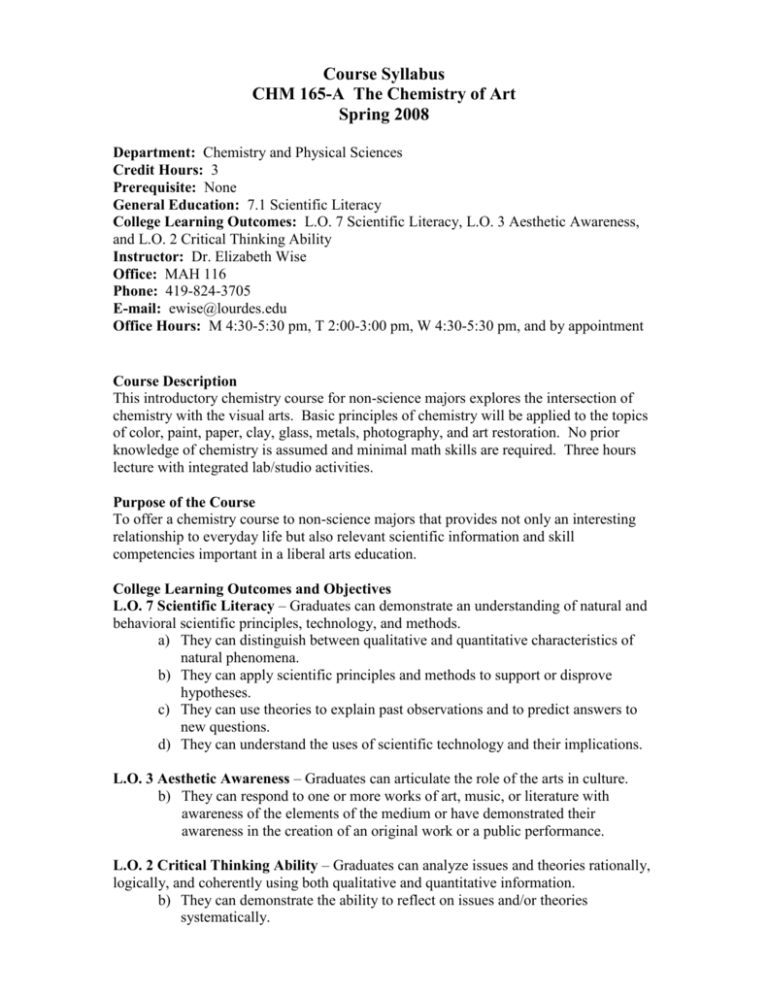
Course Syllabus CHM 165-A The Chemistry of Art Spring 2008 Department: Chemistry and Physical Sciences Credit Hours: 3 Prerequisite: None General Education: 7.1 Scientific Literacy College Learning Outcomes: L.O. 7 Scientific Literacy, L.O. 3 Aesthetic Awareness, and L.O. 2 Critical Thinking Ability Instructor: Dr. Elizabeth Wise Office: MAH 116 Phone: 419-824-3705 E-mail: ewise@lourdes.edu Office Hours: M 4:30-5:30 pm, T 2:00-3:00 pm, W 4:30-5:30 pm, and by appointment Course Description This introductory chemistry course for non-science majors explores the intersection of chemistry with the visual arts. Basic principles of chemistry will be applied to the topics of color, paint, paper, clay, glass, metals, photography, and art restoration. No prior knowledge of chemistry is assumed and minimal math skills are required. Three hours lecture with integrated lab/studio activities. Purpose of the Course To offer a chemistry course to non-science majors that provides not only an interesting relationship to everyday life but also relevant scientific information and skill competencies important in a liberal arts education. College Learning Outcomes and Objectives L.O. 7 Scientific Literacy – Graduates can demonstrate an understanding of natural and behavioral scientific principles, technology, and methods. a) They can distinguish between qualitative and quantitative characteristics of natural phenomena. b) They can apply scientific principles and methods to support or disprove hypotheses. c) They can use theories to explain past observations and to predict answers to new questions. d) They can understand the uses of scientific technology and their implications. L.O. 3 Aesthetic Awareness – Graduates can articulate the role of the arts in culture. b) They can respond to one or more works of art, music, or literature with awareness of the elements of the medium or have demonstrated their awareness in the creation of an original work or a public performance. L.O. 2 Critical Thinking Ability – Graduates can analyze issues and theories rationally, logically, and coherently using both qualitative and quantitative information. b) They can demonstrate the ability to reflect on issues and/or theories systematically. Course Objectives After completing the course, students should be able to: 1) Students should be able to understand and use basic chemical principles and terminology. (L.O. 7a-d) 2) Students should possess an awareness of the influence of chemistry in the visual arts. (L.O. 7a-d) 3) Students should be able to identify the chemicals and/or materials used in various works of art. 4) Students should be able to form opinions based on sound scientific reasoning. (L.O. 2b) Policies 1. Policy on Emergency Response In case of a tornado your instructor will direct you to the nearest shelter, in accordance with Lourdes College’s Policy for Tornado Warnings and Tornado Warning Procedures. The nearest shelter for this course is the basement of MAH or the lowest accessible level of MAH in an area that is not exposed to windows. In case of fire your instructor will help direct you to the nearest exit. Please evacuate in a calm and efficient manner. Do not use the elevator. Do not block building entrances once you are out. Also, refer to the Emergency Evacuation Procedure for Persons with Disabilities if this would apply to persons in your classroom. 2. Statement on Disabilities If you have documented a disability with the Director of Academic Services, please discuss with me: the adaptations or the accommodations you have established with the Director of Academic Services emergency medical information, and/or special arrangements to be implemented if the building must be evacuated. 3. Statement on Academic Honesty Academic dishonesty will not be tolerated. This includes any form of cheating or plagiarism. Persons not following the policies found in The Lourdes College Student Handbook will be sanctioned according to the established guidelines. 4. Statement on Academic Grievance A student who believes that an error or injustice (e.g., regarding a grade) has occurred in an academic course should contact the instructor about the issue as soon as possible. Most often, the problem can be quickly resolved. (If, as in the example, there is a grade change, the instructor will notify the Registrar in writing.) In situations where the student is dissatisfied with the response of the instructor, the student may appeal to the Department Chairperson. In this case, the Academic Grievance Tracking Form should be used (available from the instructor). If the question is still not resolved to the student’s satisfaction, the student may appeal to the Dean of the appropriate School. If resolution is not obtained in discussion with the Dean, the student may appeal to the Vice President for Academic Affairs. The decision of the Vice President for Academic Affairs in the matter is final. 5. Attendance Policy Regular attendance at lecture is strongly advised. If a grade is borderline, the attendance record will be one factor used to determine the final grade. Chemistry builds on continuity – the understanding of a later concept usually depends on the understanding of earlier ones. In the event of an absence due to a legitimate reason (e.g. death in the family, personal illness, religious holidays), please notify the instructor as soon as possible. It is the student’s responsibility to get lecture notes and assignments. If an exam is missed, documented proof of the absence must be provided in order to reschedule the exam. If you arrive after a quiz has begun, you may take the quiz but without extra time. The exception is that if all other quizzes are handed in, you may not take the quiz. 6. Evaluation Your grade will be based on how well you meet the course requirements as determined by exams, quizzes, in-class activities, a book report, and homework. Your overall average for the course will be calculated as follows: Exams Quizzes In-Class Activities Book Report Homework 55% 15% 15% 10% 5% Exams: There will be four exams that will consist of questions similar to those in the text and lecture, as well as more challenging questions. All exams must be taken on the day scheduled, unless arrangements are made in advance with the instructor and documented proof of the absence is provided. Any student who earned less than 70% on one exam may retake the exam (may be a different version); a maximum of 70% may replace the first grade. Quizzes: There will be announced 15-minute quizzes approximately every other week. The quiz will be given at the beginning of class and late comers will not be allowed extra time. Automatic zero for missed quiz, although you are allowed one excused absence with documented proof. The lowest quiz grade will be dropped and the rest will be averaged and added to your final grade. There are no make-up quizzes! In-Class Activities: The class will often organize into small groups to perform simple experiments, construct pieces of art, and complete worksheets. A short written summary will be required. Book Report: Students will read Tracy Chevalier’s Girl With a Pearl Earring and write a one-and-a-half to two-page report that describes Vermeer’s use of the camera obscura, complementary colors, mixing paint, and his emphasis on light. Homework: Problems, chapter outlines, or reflection questions will be assigned periodically. Grading Scale: A AB+ B BC+ 93-100% 90-92% 87-89% 83-86% 80-82% 77-79% C CD+ D DF 73-76% 70-72% 67-69% 63-66% 60-62% below 60% Bibliography Required Text*: Barbara R. Greenberg and Dianne Patterson, Art in Chemistry; Chemistry in Art. Teacher Ideas Press: Englewood, Colorado, 1998. * Copies of PowerPoint lectures will be handed out in class. These handouts may contain material not covered in the text. Additional Resources: www.webexhibits.org contains information about color and pigments. Anne Moncrieff and Graham Weaver, Science for Conservators, Volume 1, An Introduction to Materials. The Conservation Unit of the Museums & Galleries Commission: New York, 1992. W. Stanley Taft and James W. Mayer, The Science of Paintings. Springer-Verlag: New York, 2000. The American Chemical Society, Chemistry in Context, Applying Chemistry to Society, 4th Edition. McGraw-Hill Higher Education: Boston, 2003. Special Dates Monday, January 28 – Last day to drop course and receive 100% tuition Tuesday, February 26 – College In-Service, no classes March 12-23 – Spring Recess and Easter Break, no classes Monday, April 21 – Last day to withdraw, official papers must be submitted to Registrar Tentative Course Schedule Date Chapter and Topic 1-15-08 Introduction; Chapter 1 – Colors Do Matter 1-22-08 Chapter 1 – Colors Do Matter 1-29-08 Chapter 1 – Colors Do Matter 2-5-08 Exam 1 Review; Chapter 2 – Paint Does Matter 2-12-08 Exam 1 (Chapter 1); Chapter 2 – Paint Does Matter 2-19-08 Chapter 2 – Paint Does Matter; Chapter 3 – Supports and Grounds 2-26-08 College In-Service – No Class 3-4-08 Chapter 3 – Supports and Grounds; Exam 2 Review 3-11-08 Exam 2 (Chapters 2, 3); Chapter 4 – Three-Dimensional Works of Art 3-18-08 Spring Recess and Easter Break – No Class 3-25-08 Chapter 4 – Three-Dimensional Works of Art; Chapter 5 – Sculpture and Organic Chemistry 4-1-08 Chapter 5 – Sculpture and Organic Chemistry; Exam 3 Review 4-8-08 Exam 3 (Chapters 4, 5); Chapter 6 – Jewelry 4-15-08 Chapter 8 – Photography 4-22-08 Chapter 9 – The Art of Forgery 4-29-08 Chapter 10 – Chemical Hazards in Art; Exam 4 Review 5-6-08 Exam 4 (Chapters 6, 8, 9, 10)


